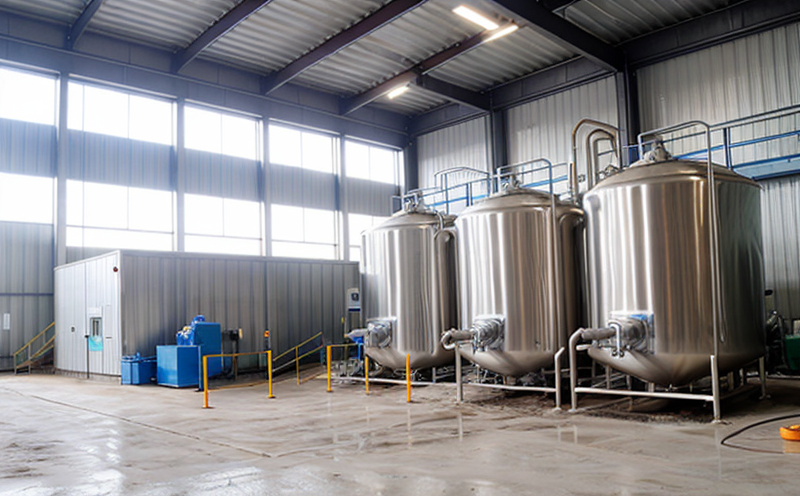ASTM D858 Sulfate Ion Test in Industrial Water
The ASTM D858 sulfate ion test is a critical analytical procedure used to determine the concentration of sulfate ions (SO₄²⁻) in industrial water. This test is essential for monitoring and ensuring the quality of industrial processes that use water as a key component, including those in manufacturing, power generation, and chemical production.
The presence of sulfate ions can have significant implications on various aspects of an industrial process. High levels of sulfate ions can lead to scaling issues in equipment, corrosion of materials, and even affect the efficiency of heat transfer processes. Therefore, precise measurement and control are vital for maintaining optimal performance and ensuring regulatory compliance.
ASTM D858 specifies a colorimetric method using barium chloride and ammonium thiocyanate reagents to precipitate sulfate ions as barium sulfate (BaSO₄). The excess reagent is then titrated against a standard solution of potassium iodide, resulting in the liberation of free iodine. The liberated iodine reacts with starch to form a blue-black complex, which can be measured spectrophotometrically for accurate quantification.
The test procedure outlined by ASTM D858 ensures high precision and reliability, making it a preferred choice for industries where water quality is paramount. For instance, in the power generation sector, this test helps prevent boiler tube corrosion and scaling issues that can reduce efficiency and increase maintenance costs. In chemical manufacturing, accurate sulfate ion levels are crucial for ensuring product purity.
Proper specimen preparation is critical to achieving accurate results. Samples must be collected aseptically, typically in glass containers, and kept cool until analysis. Pre-treatment steps may include filtration or distillation to remove interfering substances such as color, turbidity, or particulate matter that could affect the colorimetric reaction.
The testing apparatus includes a spectrophotometer for measuring the absorbance of the iodine-starch complex, calibrated against standards. The reagents required are barium chloride and ammonium thiocyanate solutions, potassium iodide, and starch indicator solution. Calibration of the spectrophotometer is necessary to ensure accurate readings.
The test results provide quantitative data on sulfate ion concentration in parts per million (ppm). Reporting these values helps quality managers make informed decisions regarding water treatment processes, equipment maintenance, and operational adjustments. Compliance officers can use this information to verify adherence to internal standards and external regulations such as the US Environmental Protection Agency's guidelines for drinking water.
The ASTM D858 sulfate ion test is a cornerstone of industrial water management, providing actionable insights that contribute to environmental sustainability by minimizing waste and optimizing resource usage. By ensuring optimal water quality, industries can enhance operational efficiency and reduce their carbon footprint.
Applied Standards
| Standard Number | Description |
|---|---|
| ASTM D858-10 | Standard Practice for Determination of Sulfate in Water by Colorimetric Method |
| ISO 7666:2013 | Water Quality - Determination of Sulphates by Spectrophotometric Methods |
The ASTM D858 sulfate ion test is standardized according to the practices laid out in the aforementioned documents. These standards provide a framework for consistent and reliable testing, ensuring that results are comparable across different laboratories.
| Reagents | Description |
|---|---|
| Barium Chloride Solution | 10% w/v in water; used to precipitate sulfate ions as barium sulfate. |
| Ammmonium Thiocyanate Solution | 25% w/v in water; used for the colorimetric reaction with iodine liberated from potassium iodide titration. |
| Potassium Iodide Solution | 10 g/L; used to liberate free iodine which reacts with starch to form a blue-black complex measured by spectrophotometry. |
| Starch Indicator Solution | 2% w/v in water; provides the color change upon reaction with liberated iodine. |
The reagents used in this test are crucial for achieving accurate and reproducible results. Calibration of the spectrophotometer is essential to ensure that readings are reliable and can be compared accurately across different instruments.
Environmental and Sustainability Contributions
The ASTM D858 sulfate ion test plays a pivotal role in promoting environmental sustainability by ensuring that industrial processes operate efficiently without compromising water quality. By monitoring sulfate ion levels, industries can prevent scaling and corrosion, which are major contributors to water wastage and pollution.
Efficient water management not only reduces operational costs but also helps minimize the impact on local ecosystems. For example, in power plants, reducing scale formation in boilers can lead to lower fuel consumption and reduced emissions. Similarly, in chemical production, maintaining optimal sulfate levels ensures product quality while minimizing waste generation.
The test results provide actionable data that help industries implement sustainable practices. This includes optimizing water usage, recycling treated wastewater, and implementing advanced treatment technologies such as reverse osmosis or ion exchange systems to further reduce environmental impact.
By adhering to ASTM D858 standards, industries contribute to broader sustainability goals by complying with regulatory requirements and promoting best practices in water management. This not only enhances corporate reputation but also supports global efforts towards a more sustainable future.
Competitive Advantage and Market Impact
The ASTM D858 sulfate ion test offers significant competitive advantages to industries that rely heavily on industrial water processes. By ensuring optimal water quality, companies can enhance operational efficiency, reduce maintenance costs, and improve product quality.
Compliance with ASTM standards demonstrates a commitment to excellence and regulatory compliance, which is highly valued by customers and stakeholders. This can lead to increased market share and enhanced brand reputation. Furthermore, the ability to provide accurate sulfate ion data allows for more precise process control, leading to improved product consistency and reduced variability.
For quality managers and R&D engineers, the test results offer valuable insights into water-related performance metrics. This data can be used to identify areas for improvement in water treatment processes and equipment design, ultimately driving innovation and competitiveness within the industry.
The market impact of this service is profound, as it directly influences the sustainability and efficiency of industrial operations. By offering reliable sulfate ion testing services, we help our clients stay ahead of regulatory changes and technological advancements, ensuring they remain competitive in a rapidly evolving market.





